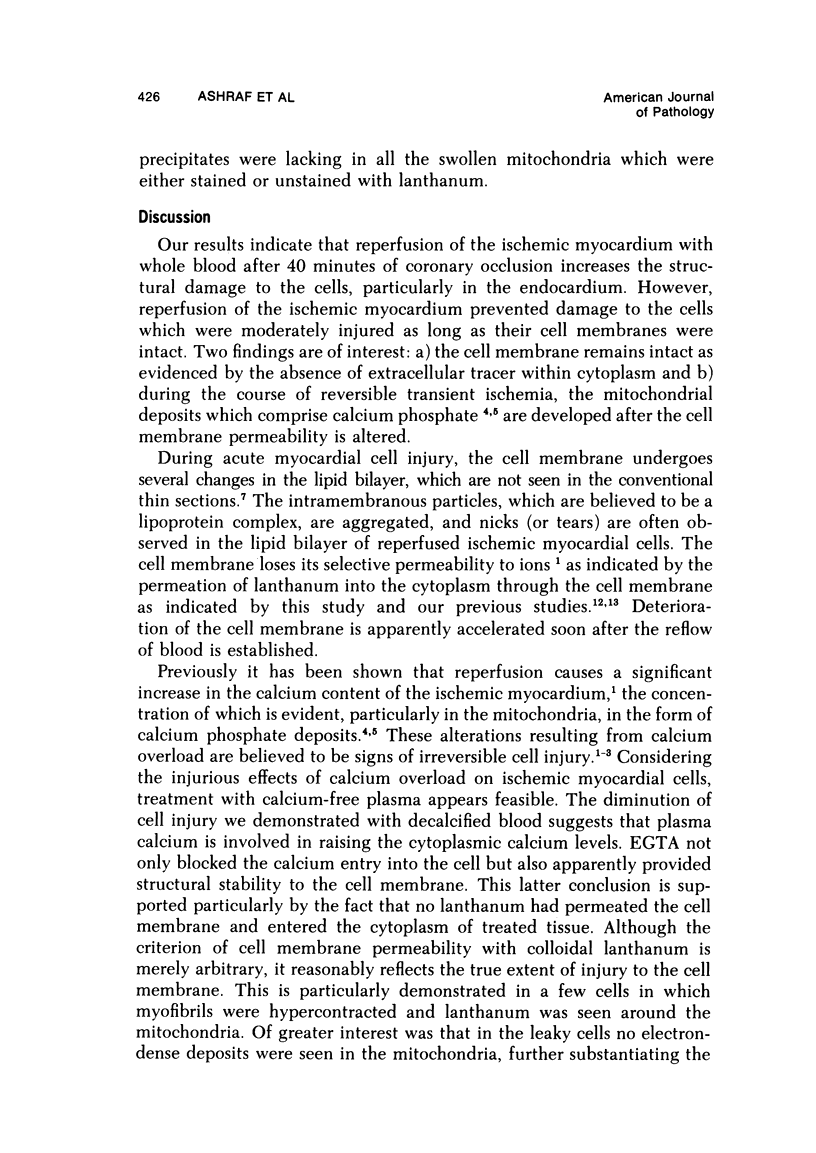Abstract
The ultrastructural effects of perfusing ischemic myocardium with calcium-free blood were determined in 12 dogs. In 6 dogs, the left anterior descending coronary artery was ligated for 45 minutes and was released for 5, 10, or 20 minutes. In 6 other dogs, the ischemic zone was perfused with blood free of calcium which was chelated with EGTA (ethylene glycol bis [B-aminoethylether-N,N'-tetraacetic acid] for 5, 10, or 20 minutes. After reperfusion with whole blood, the sarcomeres either were mildly contracted or formed contracted bands. The cells were usually pulled apart at the intercalated disk. The mitochondria were swollen and contained electron-dense deposits. Lanthanum was used as a marker for monitoring changes in cell membrane permeability and permeated into many ischemic myocardial cells. The hearts treated with calcium-free plasma showed well preserved morphology. Mitochondria were slightly swollen, their cristae were occasionally disrupted, and they lacked electron-dense deposits. No lanthanum leaked into these cells, with a few scattered exceptions. Even in the leaky cells, the mitochondria did not show any deposits. It is suggested that calcium overload plays a significant role in the pathogenesis of cell injury and that reduction in plasma levels of calcium, at least for a limited period may delay the onset of calcium overload and improve cell morphology. Alterations in the cell membrane are followed by lethal intracellular changes leading to events associated with cell death.
Full text
PDF











Images in this article
Selected References
These references are in PubMed. This may not be the complete list of references from this article.
- Ashraf M., Bloor C. M. X-ray microanalysis of mitochondrial deposits in ischemic myocardium. Virchows Arch B Cell Pathol. 1976 Dec 2;22(4):287–297. doi: 10.1007/BF02889222. [DOI] [PubMed] [Google Scholar]
- Ashraf M., Halverson C. A. Structural changes in the freeze-fractured sarcolemma of ischemic myocardium. Am J Pathol. 1977 Sep;88(3):583–594. [PMC free article] [PubMed] [Google Scholar]
- Ashraf M., Sybers H. D., Bloor C. M. X-ray microanalysis of ischemic myocardium. Exp Mol Pathol. 1976 Jun;24(3):435–440. doi: 10.1016/0014-4800(76)90077-0. [DOI] [PubMed] [Google Scholar]
- Fleckenstein A., Janke J., Döring H. J., Leder O. Myocardial fiber necrosis due to intracellular Ca overload-a new principle in cardiac pathophysiology. Recent Adv Stud Cardiac Struct Metab. 1974;4:563–580. [PubMed] [Google Scholar]
- Jennings R. B., Ganote C. E., Reimer K. A. Ischemic tissue injury. Am J Pathol. 1975 Oct;81(1):179–198. [PMC free article] [PubMed] [Google Scholar]
- Kloner R. A., Ganote C. E., Whalen D. A., Jr, Jennings R. B. Effect of a transient period of ischemia on myocardial cells. II. Fine structure during the first few minutes of reflow. Am J Pathol. 1974 Mar;74(3):399–422. [PMC free article] [PubMed] [Google Scholar]
- Lossnitzer K., Janke J., Hein B., Stauch M., Fleckenstein A. Disturbed myocardial calcium metabolism: a possible pathogenetic factor in the hereditary cardiomyopathy of the Syrian hamster. Recent Adv Stud Cardiac Struct Metab. 1975;6:207–217. [PubMed] [Google Scholar]
- Maroko P. R., Kjekshus J. K., Sobel B. E., Watanabe T., Covell J. W., Ross J., Jr, Braunwald E. Factors influencing infarct size following experimental coronary artery occlusions. Circulation. 1971 Jan;43(1):67–82. doi: 10.1161/01.cir.43.1.67. [DOI] [PubMed] [Google Scholar]
- Nayler W. G., Grau A., Slade A. A protective effect of verapamil on hypoxic heart muscle. Cardiovasc Res. 1976 Nov;10(6):650–662. doi: 10.1093/cvr/10.6.650. [DOI] [PubMed] [Google Scholar]
- Reimer K. A., Lowe J. E., Jennings R. B. Effect of the calcium antagonist verapamil on necrosis following temporary coronary artery occlusion in dogs. Circulation. 1977 Apr;55(4):581–587. doi: 10.1161/01.cir.55.4.581. [DOI] [PubMed] [Google Scholar]
- Scarpa A., Graziotti P. Mechanisms for intracellular calcium regulation in heart. I. Stopped-flow measurements of Ca++ uptake by cardiac mitochondria. J Gen Physiol. 1973 Dec;62(6):756–772. doi: 10.1085/jgp.62.6.756. [DOI] [PMC free article] [PubMed] [Google Scholar]
- Shen A. C., Jennings R. B. Kinetics of calcium accumulation in acute myocardial ischemic injury. Am J Pathol. 1972 Jun;67(3):441–452. [PMC free article] [PubMed] [Google Scholar]
- Shen A. C., Jennings R. B. Myocardial calcium and magnesium in acute ischemic injury. Am J Pathol. 1972 Jun;67(3):417–440. [PMC free article] [PubMed] [Google Scholar]
- Wrogemann K., Pena S. D. Mitochondrial calcium overload: A general mechanism for cell-necrosis in muscle diseases. Lancet. 1976 Mar 27;1(7961):672–674. doi: 10.1016/s0140-6736(76)92781-1. [DOI] [PubMed] [Google Scholar]









